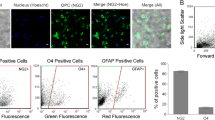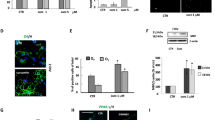Abstract
Oligodendrocyte progenitor cells (OPCs) are appropriate model cells for studying the progress of neurodegenerative disorders and evaluation of pharmacological efficacies of small molecules for treatment of these disorders. Here, we focused on the therapeutic role of Pioglitazone, which is a selective agonist of peroxisome proliferator-activated receptor gamma (PPARγ), a respective nuclear receptor in inflammatory responses. Human embryonic stem cell-derived OPCs were pretreated by Pioglitazone at differing concentrations. Pretreated OPCs were further examined after induction of inflammation by LPS. Interestingly, Pioglitazone reversed the inflammatory conditions and enhanced OPC viability. Data showed that Pioglitazone reduced Nitric Oxide (NO) production. Moreover, Pioglitazone enhanced cell viability through distinct mechanisms including reduction of apoptosis and regulation of cell cycle markers. This study demonstrated that NO induces apoptosis through FOXO1 and degradation of β-catenin, while the presence of Pioglitazone inhibited these effects in rescuing human OPCs from apoptosis. Also, Pioglitazone did not show a significant influence on mRNA levels of TLR2, TRL4, and TNFα. Furthermore, simultaneous treatment of Pioglitazone with CHIR, a GSKβ inhibitor, facilitated anti-apoptotic responses of OPCs. Taken together, therapy with Pioglitazone represents a novel potential drug in alleviating the loss of OPCs in neurodegenerative conditions.








Similar content being viewed by others
Abbreviations
- 15d-PGJ2:
-
Cyclopentenone prostaglandin 15-deoxy 12,14 prostaglandin J2
- bFGF:
-
Basic fibroblast growth factor
- EGF:
-
Epidermal growth factor
- FITC:
-
Fluorescein isothiocyanate
- GRM:
-
Glial restriction medium
- GSK-3:
-
Glycogen synthase kinase-3
- hESCs:
-
Human embryonic stem cells
- HRP:
-
Horseradish peroxidase
- IRF1:
-
Interferon regulatory factor-1
- LPS:
-
Lipopolysaccharide
- MAPK:
-
Mitogen-activated protein kinases
- MS:
-
Multiple sclerosis
- MTS/PMS:
-
[3-(4,5-dimethylthiazol-2-yl)-5-(3-carboxymethoxyphenyl)- 2-(4-sulfophenyl)-2H-tetrazolium)/phenazine methosulfate]
- NOS:
-
NO synthase
- NSCs:
-
Neural stem cells
- OPCs:
-
Oligodendrocyte progenitor cells
- PBMCs:
-
Peripheral blood mononuclear cells
- PDGF:
-
Platelet-derived growth factor
- PHA:
-
Phyto-hemagglutinin
- PI:
-
Propidium iodide
- PPARγ:
-
Peroxisome proliferator-activated receptor γ
- PVDF:
-
Polyvinylidene difluoride
- qPCR:
-
Quantitative real-time PCR
- RA:
-
Retinoic acid
- STAT1:
-
Signal transducer and activator of transcription 1
- TLR:
-
Toll-like receptor
References
Almeida M (2011) Unraveling the role of FoxOs in bone–insights from mouse models. Bone 49(3):319–327
Armoni M, Harel C, Karni S, Chen H, Bar-Yoseph F, Ver MR, Quon MJ, Karnieli E (2006) FOXO1 represses peroxisome proliferator-activated receptor-gamma1 and -gamma2 gene promoters in primary adipocytes. A novel paradigm to increase insulin sensitivity. J Biol Chem 281(29):19881–19891
Baharvand H, Ashtiani SK, Taee A, Massumi M, Valojerdi MR, Yazdi PE, Moradi SZ, Farrokhi A (2006) Generation of new human embryonic stem cell lines with diploid and triploid karyotypes. Dev Growth Differ 48(2):117–128
Bernardo A, Bianchi D, Magnaghi V, Minghetti L (2009) Peroxisome proliferator-activated receptor-gamma agonists promote differentiation and antioxidant defenses of oligodendrocyte progenitor cells. J Neuropathol Exp Neurol 68(7):797–808
Chew LJ, King WC, Kennedy A, Gallo V (2005) Interferon-gamma inhibits cell cycle exit in differentiating oligodendrocyte progenitor cells. Glia 52(2):127–143
Dasu MR, Park S, Devaraj S, Jialal I (2009) Pioglitazone inhibits Toll-like receptor expression and activity in human monocytes and db/db mice. Endocrinology 150(8):3457–3464
Drew PD, Xu J, Racke MK (2008) PPAR-gamma: therapeutic potential for multiple sclerosis. PPAR Res 2008:627463
Esfandiari F, Fathi A, Gourabi H, Kiani S, Nemati S, Baharvand H (2012) Glycogen synthase kinase-3 inhibition promotes proliferation and neuronal differentiation of human-induced pluripotent stem cell-derived neural progenitors. Stem Cells Dev 21(17):3233–3243
Franklin RJ (2002) Why does remyelination fail in multiple sclerosis? Nat Rev Neurosci 3(9):705–714
Green LC, Wagner DA, Glogowski J, Skipper PL, Wishnok JS, Tannenbaum SR (1982) Analysis of nitrate, nitrite, and [15N] nitrate in biological fluids. Anal Biochem 126(1):131–138
Huang JK, Jarjour AA, Nait Oumesmar B, Kerninon C, Williams A, Krezel W, Kagechika H, Bauer J, Zhao C, Baron-Van Evercooren A, Chambon P, Ffrench-Constant C, Franklin RJ (2011) Retinoid X receptor gamma signaling accelerates CNS remyelination. Nat Neurosci 14(1):45–53
Kanakasabai S, Pestereva E, Chearwae W, Gupta SK, Ansari S, Bright JJ (2012) PPARγ agonists promote oligodendrocyte differentiation of neural stem cells by modulating stemness and differentiation genes. PLoS ONE 7(11):e50500
Lehnardt S, Lachance C, Patrizi S, Lefebvre S, Follett PL, Jensen FE, Rosenberg PA, Volpe JJ, Vartanian T (2002) The toll-like receptor TLR4 is necessary for lipopolysaccharide-induced oligodendrocyte injury in the CNS. J Neurosci 22(7):2478–2486
Lin CF, Tsai CC, Huang WC, Wang CY, Tseng HC, Wang Y, Kai JI, Wang SW, Cheng YL (2008) IFN-gamma synergizes with LPS to induce nitric oxide biosynthesis through glycogen synthase kinase-3-inhibited IL-10. J Cell Biochem 105(3):746–755
Miglio G, Rosa AC, Rattazzi L, Grange C, Collino M, Camussi G, Fantozzi R (2011) The subtypes of peroxisome proliferator-activated receptors expressed by human podocytes and their role in decreasing podocyte injury. Br J Pharmacol 162(1):111–125
Molina-Holgado E, Vela JM, Arévalo-Martín A, Guaza C (2001) LPS/IFN-gamma cytotoxicity in oligodendroglial cells: role of nitric oxide and protection by the anti-inflammatory cytokine IL-10. Eur J Neurosci 13(3):493–502
Ochoa-Repáraz J, Mielcarz DW, Ditrio LE, Burroughs AR, Begum-Haque S, Dasgupta S, Kasper DL, Kasper LH (2010) Central nervous system demyelinating disease protection by the human commensal Bacteroides fragilis depends on polysaccharide a expression. J Immunol 185(7):4101–4108
Pakzad M, Totonchi M, Taei A, Seifinejad A, Hassani SN, Baharvand H (2010) Presence of a ROCK inhibitor in extracellular matrix supports more undifferentiated growth of feeder-free human embryonic and induced pluripotent stem cells upon passaging. Stem Cell Rev 6(1):96–107
Pershadsingh HA, Heneka MT, Saini R, Amin NM, Broeske DJ, Feinstein DL (2004) Effect of pioglitazone treatment in a patient with secondary multiple sclerosis. J Neuroinflammation 1(1):3
Petrova TV, Akama KT, Van Eldik LJ (1999) Cyclopentenone prostaglandins suppress activation of microglia: down-regulation of inducible nitric-oxide synthase by 15-deoxy-Delta 12,14-prostaglandin J2. Proc Natl Acad Sci USA 96(8):4668–4673
Polvani S, Tarocchi M, Galli A (2012) PPARγ and oxidative stress: Con(β) catenating NRF2 and FOXO. PPAR Res 2012:641087
Pouya A, Satarian L, Kiani S, Javan M, Baharvand H (2011) Human induced pluripotent stem cells differentiation into oligodendrocyte progenitors and transplantation in a rat model of optic chiasm demyelination. PLoS ONE 6(11):e27925
Sabo JK, Cate HS (2013) Signalling pathways that inhibit the capacity of precursor cells for myelin repair. Int J Mol Sci 14(1):1031–1049
Schmidt S, Moric E, Schmidt M, Sastre M, Feinstein DL, Heneka MT (2004) Anti-inflammatory and antiproliferative actions of PPAR-gamma agonists on T lymphocytes derived from MS patients. J Leukoc Biol 75(3):478–485
Tahamtani Y, Azarnia M, Farrokhi A, Sharifi-Zarchi A, Aghdami N, Baharvand H (2013) Treatment of human embryonic stem cells with different combinations of priming and inducing factors toward definitive endoderm. Stem Cells Dev 22(9):1419–1432
Vartanian T, Li Y, Zhao M, Stefansson K (1995) Interferon-gamma-induced oligodendrocyte cell death: implications for the pathogenesis of multiple sclerosis. Mol Med 1(7):732–743
Wang Y, Ren Z, Tao D, Tilwalli S, Goswami R, Balabanov R (2010) STAT1/IRF-1 signaling pathway mediates the injurious effect of interferon-gamma on oligodendrocyte progenitor cells. Glia 58(2):195–208
Yki-Järvinen H (2004) Thiazolidinediones. N Engl J Med 351(11):1106–1118
Acknowledgements
We thank our colleagues and Royan staff members for their association and helpful discussion in this project. This study was supported Royan Institute. None of the authors have any conflicts of interest to disclose and all authors support submission to this journal.
Author information
Authors and Affiliations
Contributions
MP contributed to the conception and design of the work, acquisition of data, analysis and interpretation of data, and drafted sections of the manuscript. M-SH contributed to the acquisition and analysis of data. AG contributed to the acquisition of data and drafted sections of the manuscript. AK-E contributed to the acquisition of data and drafted sections of the manuscript. KG contributed to the design of work, analysis and interpretation of data, and finalized the manuscript. MHN-E contributed to the design of work, analysis and interpretation of data, and finalized the manuscript. HB contributed to the design of work, analysis and interpretation of data, and finalized the manuscript.
Corresponding authors
Rights and permissions
About this article
Cite this article
Peymani, M., Ghaedi, K., Hashemi, MS. et al. Ameliorating the Effect of Pioglitazone on LPS-Induced Inflammation of Human Oligodendrocyte Progenitor Cells. Cell Mol Neurobiol 38, 517–527 (2018). https://doi.org/10.1007/s10571-017-0500-6
Received:
Accepted:
Published:
Issue Date:
DOI: https://doi.org/10.1007/s10571-017-0500-6




